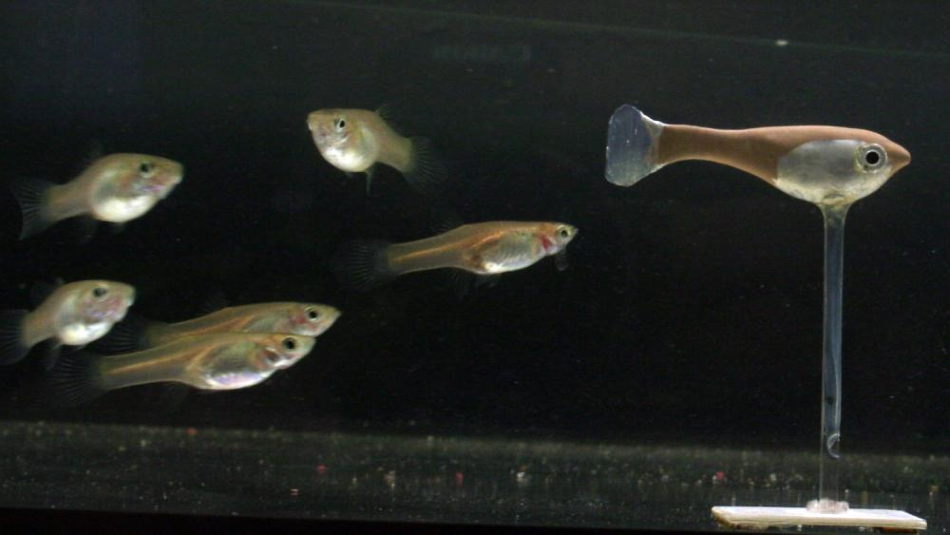Sep 17 2020
Since the beginning of time, humans have been fascinated by the remarkable and complex visual patterns created by animal groups moving together. Individuals can imagine the circular motion of a school of barracudas or the extremely synchronized movements of a flock of starlings.
 The Robofish with real guppies. Image Credit: David Bierbach.
The Robofish with real guppies. Image Credit: David Bierbach.
Using advanced robotics, a research group from the University of Konstanz, Science of Intelligence, and Leibniz Institute of Freshwater Ecology and Inland Fisheries (IGB) has demonstrated that the speed of animals is essential for collective behavioral patterns, and that eventually, it is the faster creatures that have the strongest impact on group-level behavior.
Published in the Biology Letters of the Royal Society, the study sheds new light on multifaceted collective behavioral patterns in nature and gives knowledge that could help build robotic systems that move in a group, such as drones, robot swarms, and autonomous cars.
For a long time, scientists have focused on finding the emergence of collective patterns. With a combination of computer simulations, behavioral experiments, and field observations, it is evident that many apparently complex patterns can be explained by comparatively basic rules—that is, speed up toward others if they get too far away, move away from others if they get too close, and otherwise move at the same speed and line up with group mates.
Besides understanding the rules that individuals follow when interacting with others, we need to consider the behaviors and characteristics of those individuals that make up the group and determine their influence for collective outcomes. Across the animal kingdom, it has been found again and again that animals tend to differ considerably from one another in their behavior such as in terms of their activity, risk-taking, and social behavior.
Dr Jolle Jolles, Study Lead Author and Scientist, Zukunftskolleg, University of Konstanz
What are the significances of this behavioral heterogeneity with regard to collective behavior? How can a researcher test for its social significance?
The Robofish is Recognized as a Conspecific
To unravel the role of individual differences in collective behavior and the mechanisms behind this type of behavior, the researchers built “Robofish,” a robotic fish that realistically looks and acts like a guppy—a tiny tropical freshwater fish—and also interacts with the live fish in a natural manner.
The researchers paired the robotic fish with a guppy and tuned it to invariably follow its partner and imitate its movements, but lacking any movement choices of its own. The researchers then used a closed-loop feedback system and high-definition video monitoring to allow the robotic fish to react to the actions of the live fish in real-time.
One of Robofish’s simple interaction rules was to keep a constant distance to its shoal mate.
Dr David Bierbach, Study Senior Author, Leibniz Institute of Freshwater Ecology and Inland Fisheries
Dr Bierbach works within the Berlin-Based Excellence Cluster “Science of Intelligence” at the HU Berlin and the IGB.
He added, “Using this rule, our Robofish tried to keep the same distance to the live fish by accelerating and decelerating whenever the live fish did. Also, programming the robotic fish without any own movement preferences gave us the unique opportunity to investigate how individual differences in the behavior of the live fish led to group-level differences. In short, with our unique approach, we could isolate the effect of the fish’s movement speed on the pair’s collective behavior.”
Fast Guppies Become Stronger Leaders
The team initially measured the guppies’ natural movement speed by noticing their movements when alone in an open surrounding and observed that there were considerable individual differences in how fast guppies were inclined to move. When the fish were later tested with Robofish, both the fish and Robofish were inclined to swim naturally together in pairs.
However, the team noticed that there were large differences in the social behaviors between the fish and Robofish: pairs in which the guppy had a faster movement speed were inclined to be relatively more coordinated, more aligned, and less cohesive, and the guppy emerged as a stronger leader.
Since Robofish acted according to the same identical rules with all the guppies, it is the guppies’ individual speed that must have resulted in these differences in group-level properties.
By employing advanced robotics, this study demonstrates that individual speed is an important factor in the emergence of collective behavioral patterns. Considering that individual variances in speed are related to a wide range of phenotypic traits among grouping animals, such as their age, size, and hunger level, the study results may help comprehend the role of such heterogeneity in animal groups.
Upcoming studies using the interactive Robofish will target other aspects of collective behavior. For instance, how can animals behave in synchrony if they simply react to the actions of their neighbors?
We want to improve Robofish’s software so that it can predict and anticipate the live fish’s next steps, which is assumed to be how animals do it.
Dr David Bierbach, Study Senior Author, Leibniz Institute of Freshwater Ecology and Inland Fisheries
A deeper insight into these mechanisms is not only essentially important as it discloses information about the mechanisms underlying collective behavior and decisions, but also because this understanding can be used in artificial systems and applied to build machines that move as a group, such as driverless cars, robot swarms, and drones.
Journal Reference
Jolles, J. W., et al. (2020) Group-level patterns emerge from individual speed as revealed by an extremely social robotic fish. Biology Letters of the Royal Society. doi.org/10.1098/rsbl.2020.0436.